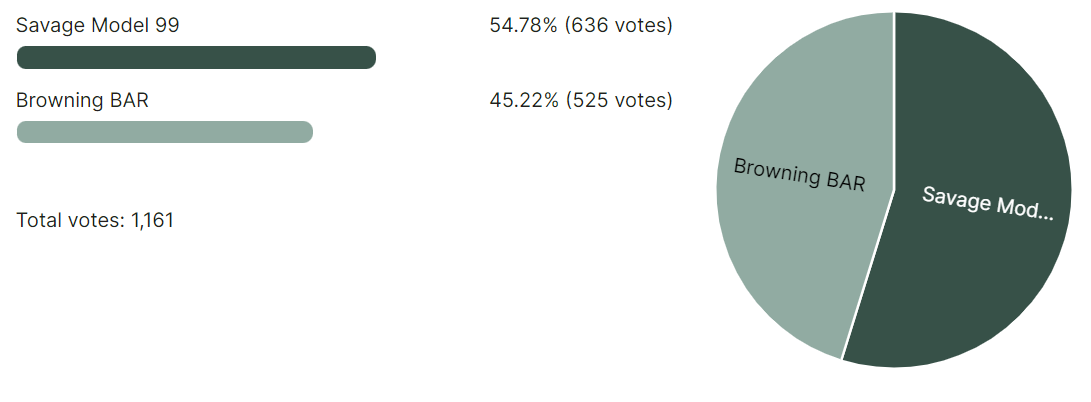
Voting for this matchup has concluded, and the Remington 700 is the winner!

------------------
The first round of October Madness 2024 is in the books with a narrow victory for the Savage Model 99 (55% of the vote) and a more decisive win for the ol' Remmy 700 (67% of the vote).


Now, these two iconic rifles go head to head for a chance at the Finals to face the winner of the Winchester Model 70 vs. Marlin Model 336 matchup. Scroll down to the poll at the bottom of this article to cast your vote, and the rifle with the most votes by 11:59pm on Thursday, October 3rd will advance to the final round. If you'd like a little more information before casting your vote, check out the cheat sheets on each rifle below. And feel free to explain your vote in the comments (or why the other side is dead wrong).

Don’t forget to vote in the other matchups, which you can do here.
Remington 700
If you can think of a centerfire rifle cartridge, you can probably find a Remington 700 that shoots it. Some of the more popular ones include.
History
Ask any hunter to name the most famous bolt-action rifle of all time, and chances are they’ll say the Remington 700. The company claims that more 700s have been produced than any other bolt gun since the rifle’s introduction in 1962, and I don’t know anyone who would disagree.
The Remington 700 traces its roots all the way back to the M1917 Springfield, which was used extensively in World War I. The Remington Model 30 took its cues from this military rifle, and the Remington Model 721 was an updated version of the Model 30. But neither rifle did well commercially against Winchester’s Model 70, so Big Green went back to the drawing board. They came up with the Model 700, which was cheaper to make but still maintained tight tolerances and high quality.
The 700 was an immediate success, and its various configurations have been widely adopted by hunters as well as American military snipers, whose M24 and M40 rifles are based on the Model 700 design.
Features
The Model 700 has been offered in so many barrel, stock, and trigger configurations that it’s tough to summarize the rifle’s many potential features. Rifles boast capacities of three, four, and five rounds in blind internal box and hinged floorplate magazines, and many companies produce stocks that can accept detachable magazines.
The heart of the 700 is the action, which Remington has claimed is the strongest on the market thanks to its “three rings of steel” (bolt head, receiver, and barrel) that enclose the cartridge prior to firing. Other features of the action include dual opposing lugs, a c-clip extractor, and a plunger ejector. While various companies offer aftermarket triggers for the 700, Remington has partnered with Timney Triggers to provide upgraded versions of their factory triggers.
Availability
You can still purchase a factory-new Model 700 from Remington (now operated by the holding company RemArms). These are available in 14 variants featuring different barrel and stock options, and can be found in the $600 to $1200 range. Used Remington 700’s are ubiquitous–meaning, you could throw a dart blindfolded in a gun store and probably hit one. Many gun makers have also used the Remington 700 action footprint to produce stocks, triggers, receivers, and barrels, so finding aftermarket accessories for a 700 is a piece of cake.
History
Named after the year it was conceived, the Savage Model 1899 (eventually shortened to Model 99 in 1921) was a highly innovative hunting rifle for the turn of the twentieth century. It sported an internal hammer, cocking indicator, and brass round counter on the side of the receiver. Also, unlike its tube-fed contemporaries, the 99’s rotary style magazine allowed for spitzer style bullets, so it wasn’t limited to flat nose cartridges like the Winchester 94 or Marlin 336.
In fact, shortly after WWI, Savage introduced the .300 Savage, which boasted the same ballistic performance as the .30-06 at that time. The .300 Savage skyrocketed, and other gun manufacturers took advantage of Savage’s brainchild. While it’s still a solid hunting round today, the rise of the .308 sealed its future in obscurity.
Features
The M99’s rotary style magazine immortalized this rifle, but other features made it one of the best hunting rifles of all time. Internally, the 99’s lever connects to a breech block that locks the action as the lever is closed. This solid action allowed for high-pressured cartridges. Rather than a typical “brush gun,” the Savage 99’s design made it a lever action capable of impressive ballistic feats for the time.
The cocking indicator, round counter, and lever-locking safety were a few other innovative trademarks of the M99 that made (and still make) sense for a big woods hunting rifle.
Even the fit and finish of the M99 scream deer hunting rifle. The two-part stock, which features a separate fore-end and buttstock, make shouldering the rifle comfortable and natural. The metal, rounded receiver also sits nicely in your hand, which makes it a joy to tote, so much so, that I removed the sling that came with the M99 I bought.
Availability
Savage discontinued the M99 in 1997. By then, the company had changed hands multiple times since its inception, and the rising costs made it impractical to continue their beloved lever action.
While Savage probably won’t resurrect the M99, there are plenty of used ones floating around gun shops across the country. If you’re in the market for one, don’t expect to find a decent M99 for less than $800, and immaculate ones can run double that. It’s a lot of cash for a rifle that begs for hard hunting, but I can’t think of a rifle that’s more fun to deer hunt with.








Conversation